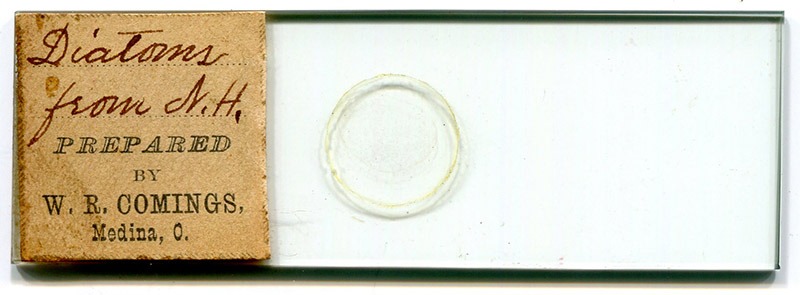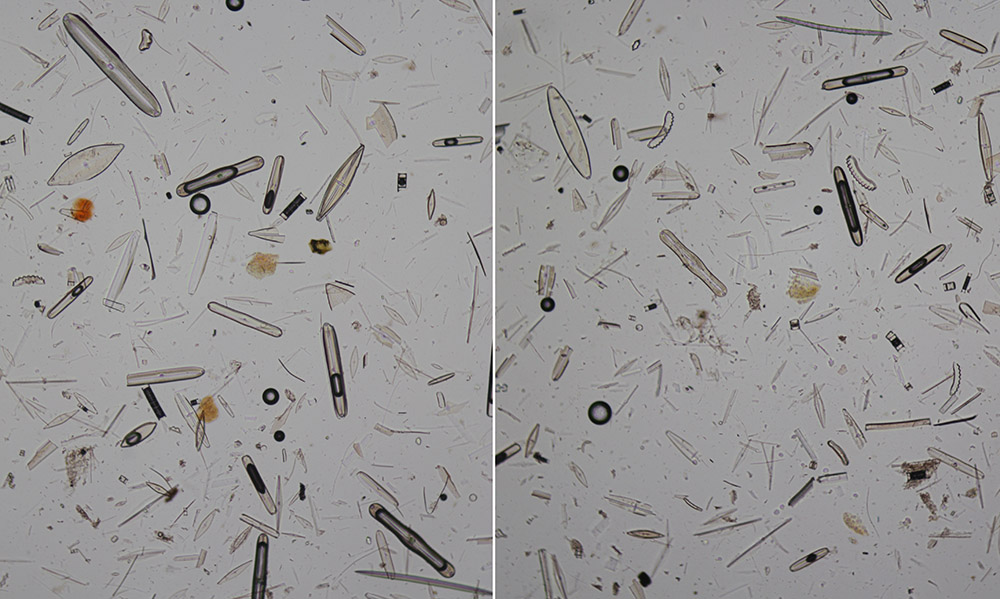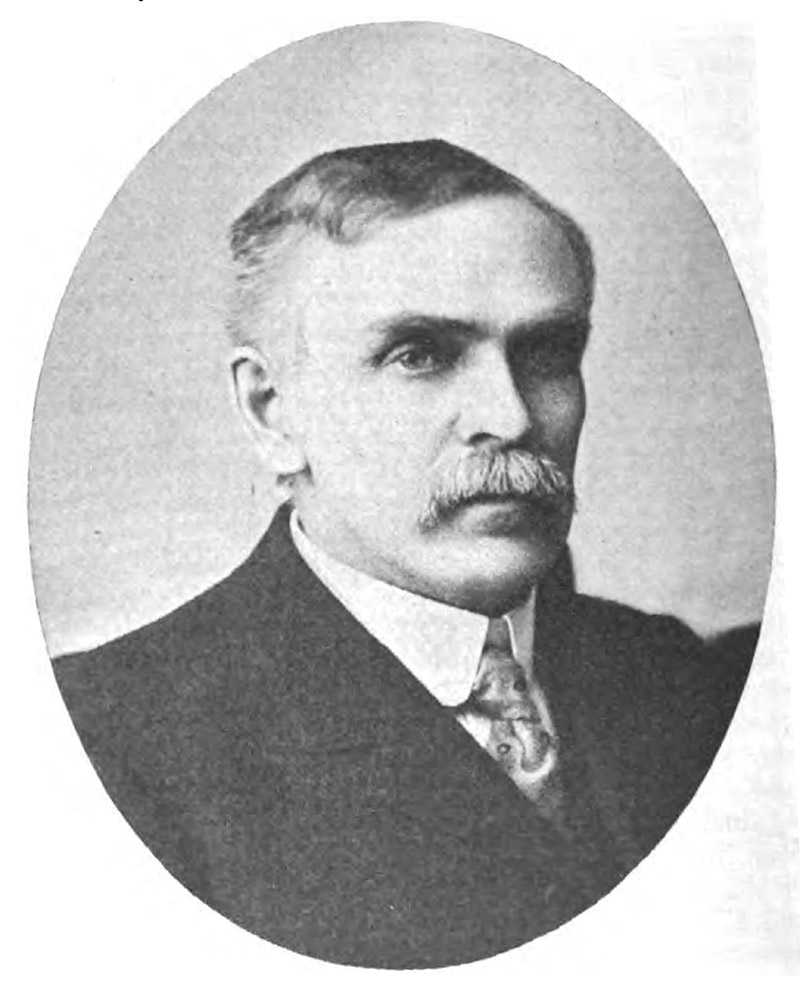
Figure 1. A mixed strew of diatoms from New Hampshire, prepared ca. 1877 by William R. Comings.
William Raymond Comings, 1851 - 1943
by Brian Stevenson
last updated August, 2023
As with all hobbies, some people initially get very excited about microscopes, then soon loose interest. W.R. Comings appears to have been such a microscopist. Extensive searches have revealed only a single document of his microscopical interests: an 1877 appeal for microscope slides in exchange for his mounts of diatoms from New Hampshire (Figures 1 and 2). Comings may have continued to use his microscope to some extent, but he does not appear to have attempted further exchanges, joined a club, etc.
Although his time as a microscopist appears to have been brief, Comings’ did a professional-quality job with his New Hampshire diatom preparation, with a dense strew of multiple species, a clean finish, and a nicely type-set custom label (Figures 1 and 3).
Comings’ diatom slide and exchange offer come from the time when he lived in Medina, Ohio, USA. He was then a young man, working as a school teacher and administrator, with hopes of marriage and a family.
Published exchange offers from the 1870s – 1900s indicate that there was a sizeable community of Americans, spread across the vast country, who shared enthusiasm for looking into the microscopical world. Despite there having been numerous American slide-makers during the heyday of amateur microscopy, their slides are rarely found for sale nowadays. By highlighting Comings and other early American mounters, I hope that people who have boxes of their ancestors’ slides in dusty attics and garages might recognize their value to collectors, and make them available.

Figure 1.
A mixed strew of diatoms from New Hampshire, prepared ca. 1877 by William R. Comings.

Figure 2.
An 1877 exchange offer from W.R. Comings, in which he advertised to provide a slide such as that shown in Figure 1, in exchange for another slide from a microscopist who lived elsewhere in the US. His plan worked to some extent, as the slide shown in Figure 1 was found in a collection of ca. 1870s slides that I acquired from California. The advertisement is from “The American Journal of Microscopy and Popular Science”.

Figure 3.
Views of diatoms from New Hampshire, prepared by W.R. Comings. Photographed with a 10x objective and C-mounted digital SLR camera on a Leitz Ortholux II camera.
William Raymond Comings was born on February 16, 1851, in East Berkshire, Vermont. He was the fifth of seven children of Andrew and Amanda Comings, who owned a farm. The Comings family was evidently financially stable, as William and two of his younger brothers were listed as students of Oberlin College, Ohio, in 1868. William did not complete his studies for a degree there, although he was later awarded an Honorary A.M. degree from Oberlin in 1886.
Leaving Oberlin, Comings spent a year in Chicago, working as a “mercantile collector”. He took courses at schools there, and in Kirksville, Missouri. In 1874, he was appointed Superintendent of Schools for Medina, Ohio.
In 1877, he advertised in The American Journal of Microscopy and Popular Science to exchange microscope slides, offering his own preparations of “diatoms from New Hampshire” (Figures 1-3).
William Comings married Loretta Kennedy in Medina on July 31, 1878.
In about 1882, Comings moved to Norwalk, Ohio, to serve as that city’s School Superintendent. Around 1891, he became Superintendent of the Ironton, Ohio, schools.
A bit of teaching advice from W.R. Comings was published in 1892: “Too much help in the preparation of daily lessons neutralizes all the good that might otherwise be gained. Get the pupil into deep water occasionally, but keep your eye on him.”
Comings changed his career around 1893, and moved to Springfield, Missouri to work as a newspaper editor. He moved to another newspaper around 1898, in Lorain, Ohio.
In 1901, he became Superintendent of Schools in Elyria, Ohio. He served as President of the Northeastern Ohio Teachers’ Association in 1908. Comings retired from the superindenceny in 1916.
He wrote the following in 1915, which is as relevant today as it was then: “If I see aright there are still larger and perhaps more vital problems coming in the next ten years than those of the past ten, and they will call for the efforts of expert and farseeing supervision. The old-time educational shell has been broken, but what the new life is to be will depend upon the wisdom and sagacity of a new generation of men who are rapidly coming to the front... It is time for old men and for men who hark back to the old conditions to retire."
Comings was elected to serve in the Ohio House of Representatives in 1916, and again in 1918. He was then elected to the state Senate.
W.R. Comings died on October 30, 1943, at the age of 92.

Figure 4.
W.R. Comings in 1908, when he was President of the Northeastern Ohio Teachers’ Association. From “The Ohio Educational Monthly”.
Resources
American Journal of Microscopy and Popular Science (1877) Exchange offer from W.R. Comings, Vol. 2, page 172
Catalogue of Oberlin College for the Years 1868-1869 (1868) page 24
Legislative Manual of the State of Ohio, 1917-1918 (1817) William R. Comings, page 111
Legislative Manual of the State of Ohio, 1919-1920 (1819) William R. Comings, page 148
Michigan School Moderator (1892) Quote from W.R. Comings, Vol. 12, page 357
Oberlin Alumni Magazine (1916) “1886 A.M. Hon., Superintendent W. R. Comings of the Elyria schools has tendered his resignation, to take effect at the end of the present school year. Mr. Comings has been at the head of the Elyria schools for the last fifteen years and has done much towards their development”, Vol. 12, page 143
Official Report of the American Association of School Administrators (1886) “Supt. W.R. Comings, of Norwalk, Ohio, said: I am familiar with the school system of no State except Ohio, and Ohio has no system outside of the cities. This want of a system is a misfortune to the State and will probably remain so”, Government Printing Office, Washington, page 105
The Ohio Educational Monthly (1908) Supt. W.R. Comings, Vol. 57, pages 127-128
Ohio Legislative History: 1913-1918 (1918) page 539
US census and other records, accessed through ancestry.com
Wright, George F. (1916) A Standard History of Lorain County, Ohio, Vol. 2, Lewis Publishing, Chicago and New York, pages 722-723